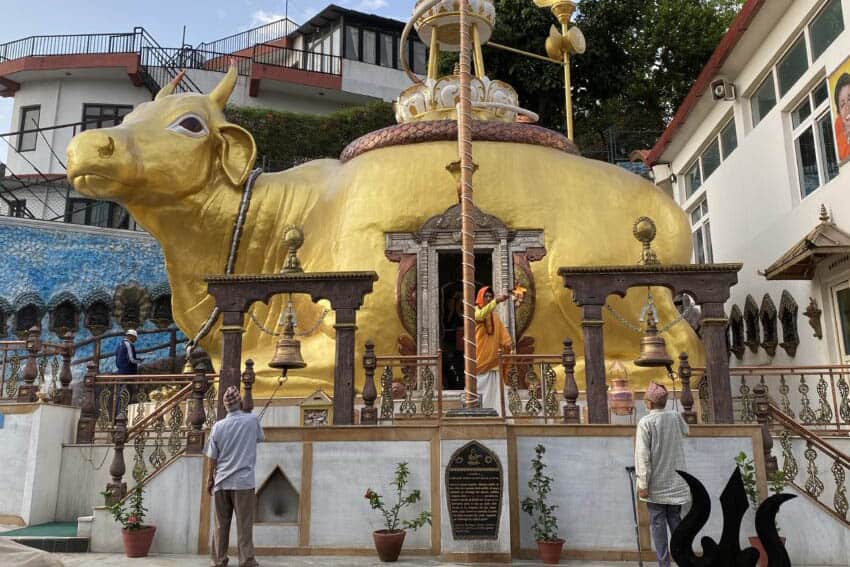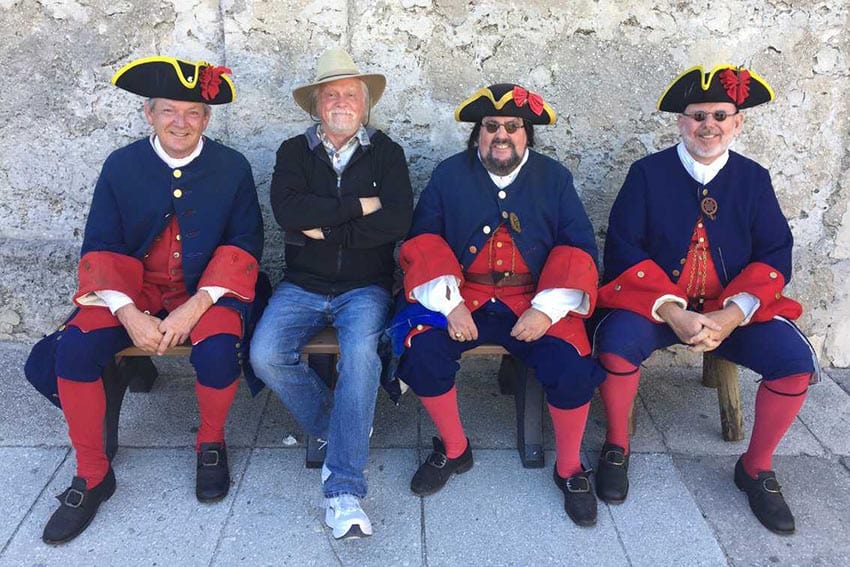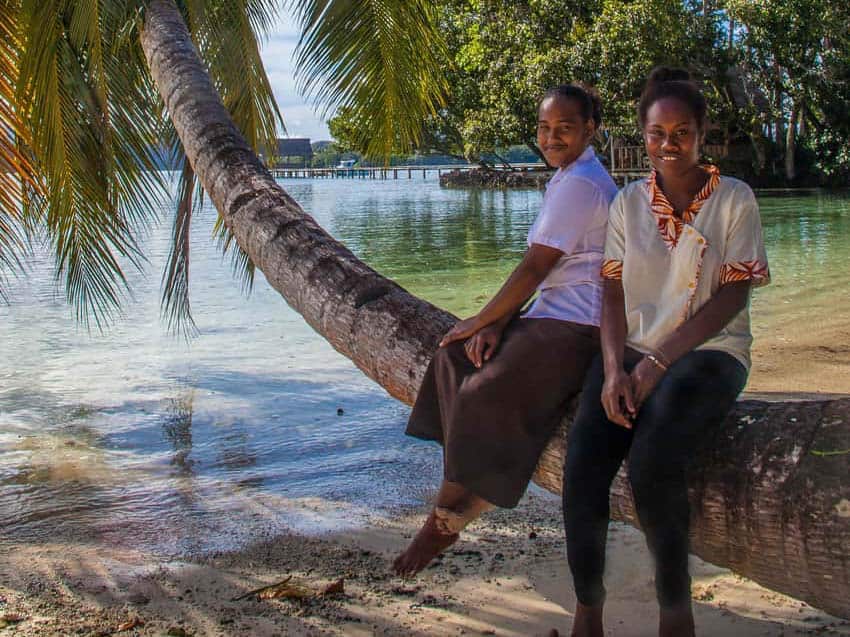
Secrets of the Solomons: From War to Wonderland in 75 years
By Anne Z. Cooke
If it weren’t for the potholes, cavernous pits slowing us down on the road to Honiara, in the Solomon Islands, I might have missed the sign on the tree, “Dolphin View Cottage.”
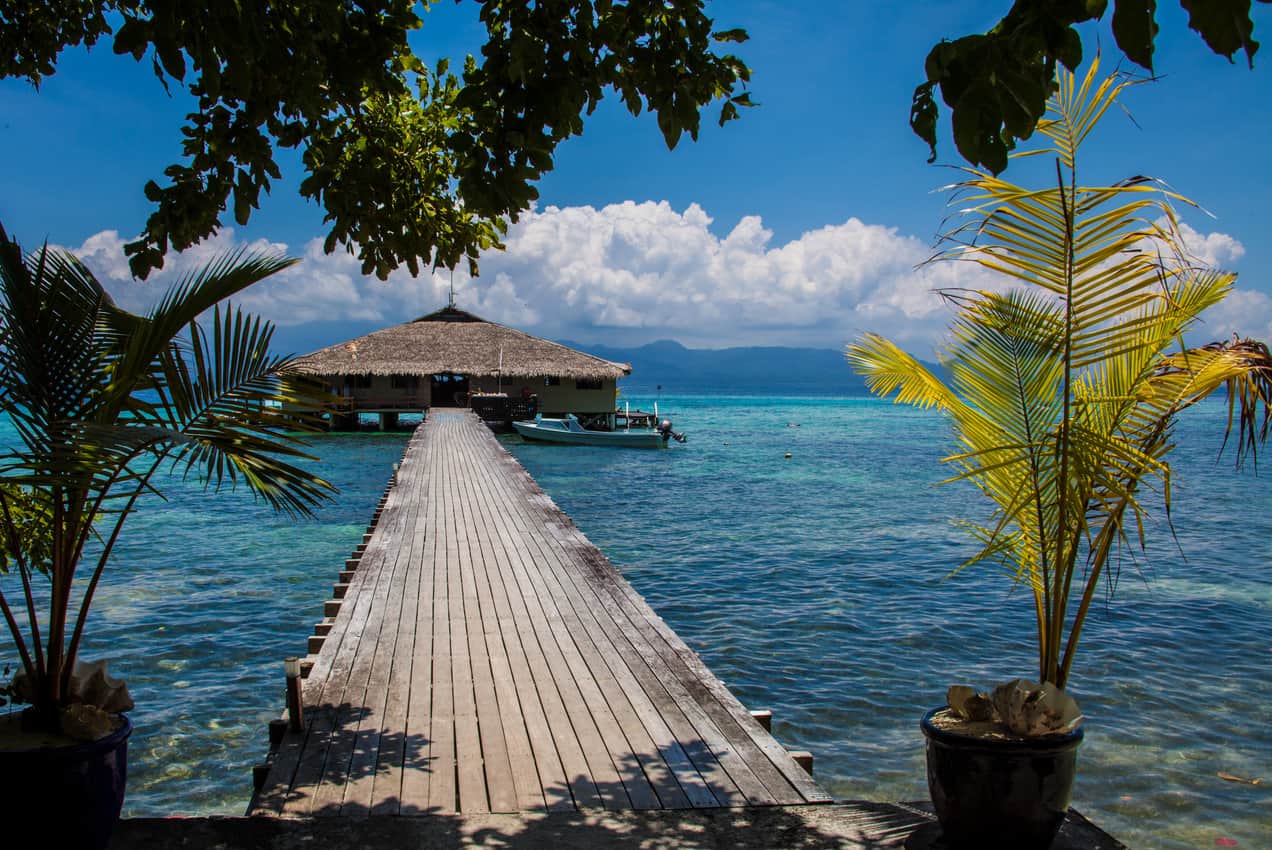
But Andrew, our guide, spotted it instantly.
“Hey, that’s Guyas Tohabellana,” he said, waving at a stocky, dark-skinned man in rumpled shorts, a faded t-shirt, and flip flops. “He works here in Guadalcanal. C’mon, let’s say hello.”
Beyond the bungalow, Guyas’s two teenagers lounged on a picnic table, playing with their pet cockatoo. Behind them, the beach sloped down to Iron Bottom Sound, the World War II graveyard where 50-odd American and Japanese ships lie at rest. Across the water, Savo Island shimmered on the horizon.
For a couple of minutes, the two men chatted, speaking Pijin so quietly I couldn’t make out the words. Then Guyas turned to me and we shook hands.
From America?
“You’re from America!” he said, switching to English and lighting up. “Do you like it here? Have you been to Gizo and seen the beautiful coral reefs?
My grandfather was a coastwatcher during World War II, a spy you’d say, reporting Japanese movements to the Americans. He watched the battle of Savo Island from right here.”
A name and a handshake are de rigueur in the Solomon Islands, west of Samoa, in the South Pacific. Being American counts, too, especially on Guadalcanal, where 5,800 Americans were killed or injured in the fight to defeat the invading Japanese.
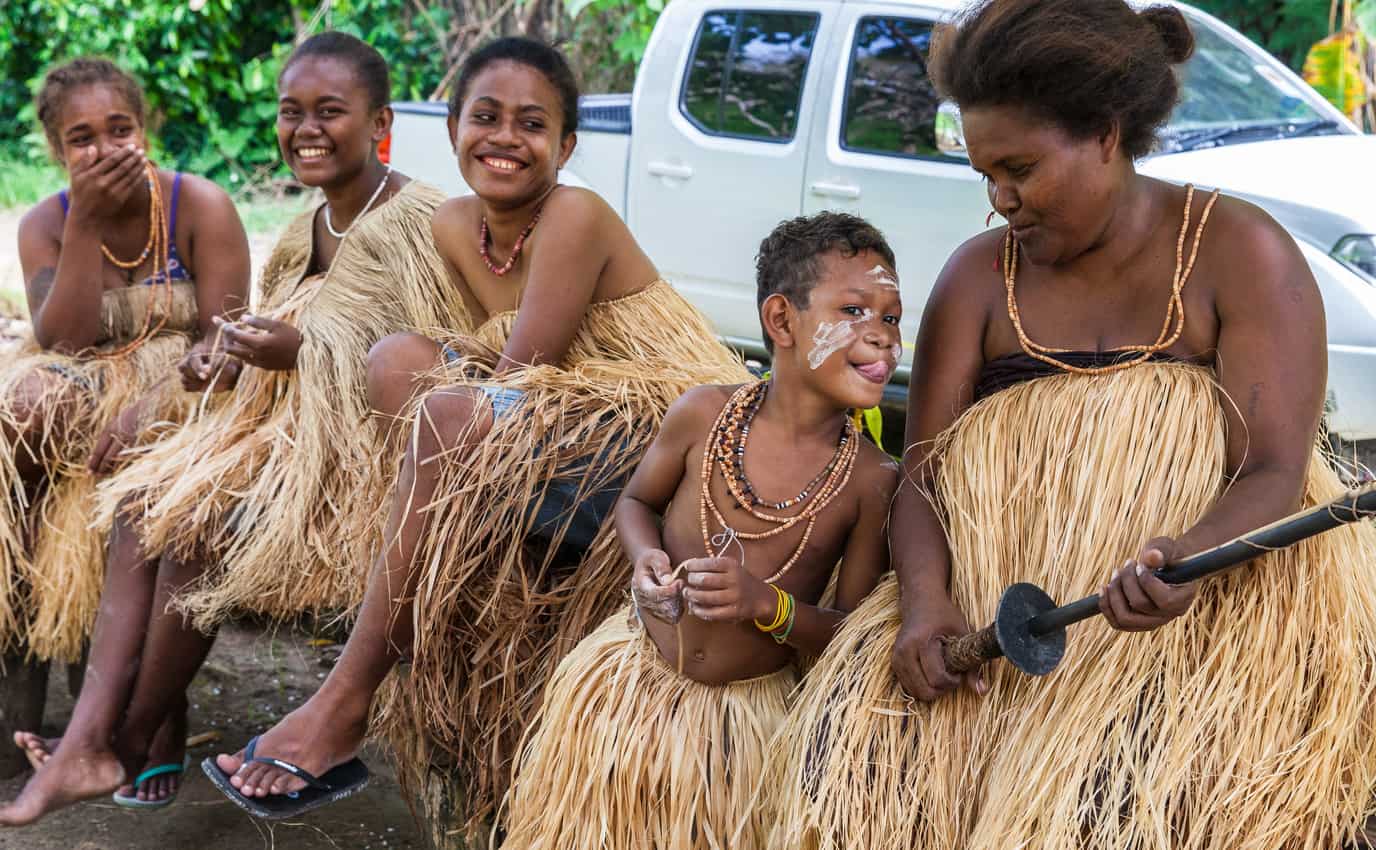
“We’re known for two things,” said Ellison Kyere, from the tourist office, when my partner Steve and I met him for lunch at the Lime Lounge Cafe, in Honiara. “For the battle sites and for scuba diving, under the water. We think it’s time to tell the story of island life on land.”
922 Islands
A tall order, indeed. The Islanders, mostly Melanesian, are scattered over 347 of the country’s 922 islands.
Though all speak Pijin – a simplified form of English – they also speak one of the country’s 75 different languages. Some islanders are farmers; some work for the government.
Some wear grass skirts and use shell money for barter; others are proud to count headhunters among their ancestors. A few own speed boats, but most paddle to the nearby islands in a mola – a dug-out canoe.
Getting there was surprisingly easy, despite the distance. We took the overnight Fiji Airways flight from Los Angeles to Fiji’s Nadi airport, at lunch in the terminal, changed to a Solomon Airlines flight and went on Honiara, the capital city, landing at the famous Henderson International Airport.
Buying a SIM Card
I’d brought my phone so when I saw the sign, advertising the “Tourist Special,” a SIM card good for 75 minutes, for U.S. $1.30, I bought one, swapped it in and within a few minutes, had booked a guide for a city tour.
We were still jet-lagged the next morning when Andrew, smiling and talkative, pulled up to our hotel in a shiny black SUV. “All our cars are Japanese and they’re all second-hand,” he said frowning.
“We never get new ones. And the Japanese are building this overpass and paving the street, and it’s taking forever,” he added as we inched along past grimy storefronts and vegetable stands overflowing with greens, melons, tomatoes, and squash.
“That one, where everybody shops, is owned by a Chinese company,” he said, nodding at a big-box department and grocery store, the kind we’ve seen in other third-world countries, where China is looking to be an economic presence, one that might lead to better-paying mining contracts.
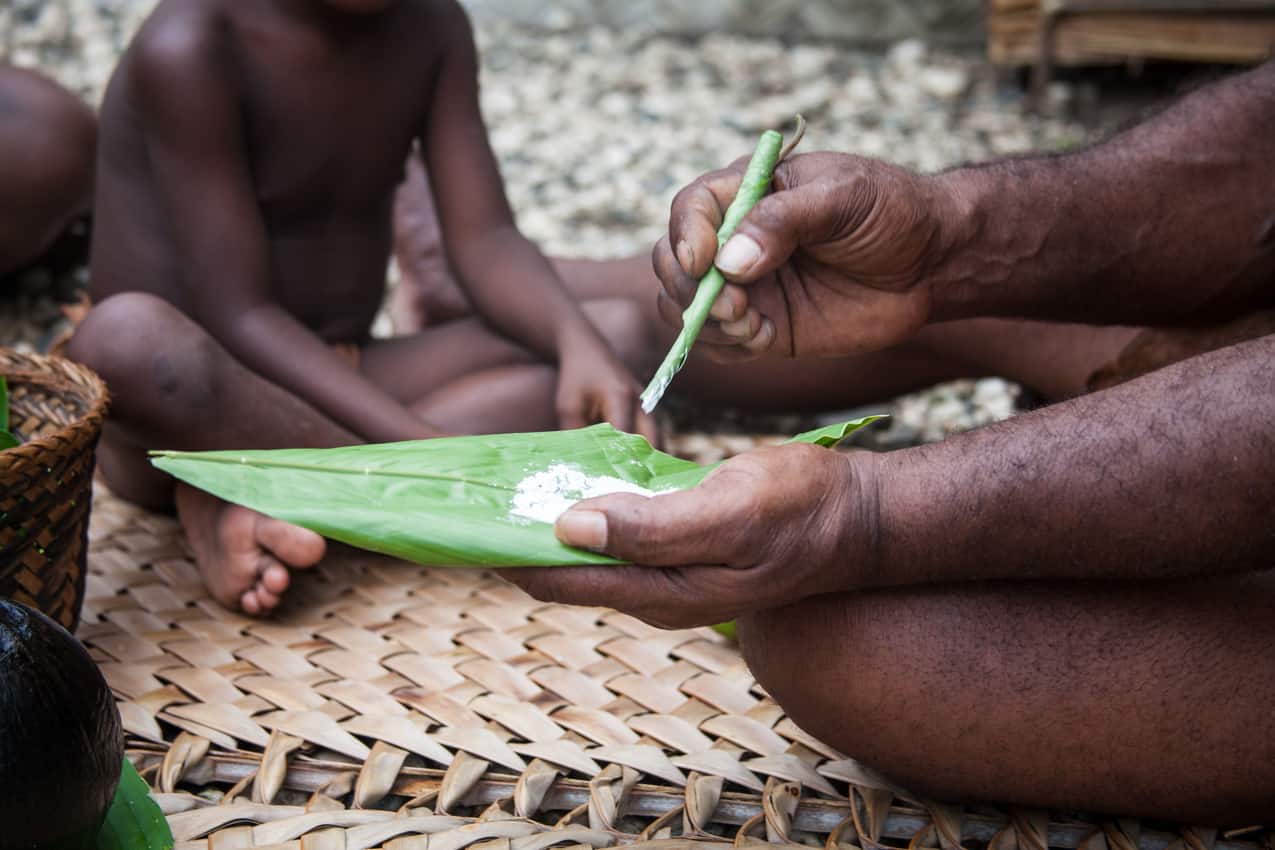
Bloody Ridge
I looked for something I could brag on – an American-built hospital or a college – but we’d already turned away, heading to the Memorial Garden Cemetery, the American War Memorial and Bonegi Beach, famous for wreck dives.
“And here’s Bloody Ridge,” Andrew said, driving up a hill and parking the car on a grassy hump of land.
Standing there, imagining the chaos of battle and the soldiers bleeding, but still in their foxholes, I felt as if I was walking with ghosts, come back to gaze again over the sleepy farm fields below and ocean beyond.
On day two, the trip – now nicknamed “Solomons 101,” – began with the flight north to the airfields at Gizo, on Ghizo Island (sic) and Munda, on New Georgia, both in the Western Province, the gateway to the riches of nature: equatorial rain forests, volcanic mountains, blue lagoons and sandy beaches.
Fat Boys Resort
With a driver and motorboat waiting, we were off, skimming over a shimmering blue lagoon, to Fat Boys Resort, an all-inclusive, palm-thatched lodge.
Built on stilts over deep water, its 200 foot-long pier connected it to five bamboo-walled guest bungalows perched on the shore.
Our base camp for three days, it was a short ride for a visit to Kennedy Island to see where Lieutenant John Kennedy and his PT109 crew swam ashore and hid after a Japanese vessel sank their ship. And it was close enough to a group of coral reefs, a perfect place to spend a couple of hours snorkeling, followed by a grilled-lobster picnic on a tiny islet.

“The rising ocean is washing the island away,” said Sam, the boat captain, explaining why one of the island’s trees, its roots at the edge of the water, seemed to be dying. “People used to think the trees had a disease,” he told me. “Now they know it’s global warming.”
Market Day in Gizo
Friday was market day at Gizo, and a party atmosphere spread over the tiny harbor as families in dugout canoes docked at the waterfront, shoppers with grocery bags crowded the aisles, coins changed hands, sellers hailed their friends and old ladies sat in the shade.
Everyone smiled, asking where we were from and posing for photos.
Ngali nuts – the holy grail of snacks here in the islands – were in season, so I stocked up with a half-dozen folded-leaf packages.
Green taro leaves competed with slippery spinach (Malabar spinach), purple bananas, carrots, and betel nuts, an affordable substitute for coffee or cigarettes.
“What do they taste like?” I asked an older man with red-rimmed gums and eyes (the clue), who offered me a seat in the shade. “Do they make you feel relaxed?” I ventured to ask.
“Oh, no, they give you energy!” he said, smiling, showing me how he folded the nut and leaf together with a pinch of slaked lime (ash from burned clamshells). “One or two of these and I want to get up and work all day.”
To Munda
The next day we flew to Munda, our base for touring one of the region’s shipwreck dives and islands once occupied by headhunters. Checking into the Agnes Gateway Hotel, on the waterfront, we were assigned a tiny cottage, clean, sparsely decorated and advertised for backpackers and divers.

Signing up for a tour to the famous Skull Island, we met boat captain Billy Kere, 30-ish and friendly; “I’m a descendant of the Roviana headhunter clan,” as he told us, steering the boat toward deep water, where we speeded over incoming swells for 40 minutes before reaching the island.
A tiny pile of rocks and one tree, Skull Island is just big enough and gloomy enough to hold a group of rock altars piled with rows of ancient skulls, victims of long ago battles.
“Don’t worry, the headhunters are gone,” said Billy, chuckling. “It’s all about love nowadays.” He paused. “But not then. If you sinned,? You’d lose your head.”
Lubaria Island
Continuing to Lubaria Island, now a National Preserve, Billy explained that this palm-shaded bit of sand was the PT-boat base where Kennedy and his crew were stationed during the war.
Guided by the keeper, Ata, a white-haired old fellow who hobbled over to help us, we toured the empty barracks, examined the rusty cannon and took note of the modern flush toilet, the only one for miles around.
Then we noticed the stone monument, dedicated to President Kennedy.
At which point Ata, who lives on the site, hurried away, back to his tent to retrieve the carved wood bust of the youthful Kennedy. Setting it atop the monument, he said that he hides it under the blankets. “It’s been stolen and recovered twice,” he told us.
As the two weeks wound down and we boarded the Solomon Airline’s 16-seat Twin Otter for the flight back to Honiara – an unexpected tour over islands, bays, coral reefs, beaches, rain forests, volcanos, mountains, and waterfalls – I realized how much we hadn’t seen.
Spectacular, pristine and endlessly varied, the Solomon Islands remain one of the last untamed destinations (www.visitsolomons.com.sb). The roads aren’t awfully good, especially on the way to Honiara.
But potholes or not, we’ll be back.
 Anne Z. Cooke, a travel and feature writer, covers the world from digs in Los Angeles and a log cabin in the Rocky Mountains. She covers everything from Arctic trekking to expedition cruising and from salmon fishing to museum stalking. A correspondent for the Tribune News Service, her stories appear National Geographic Traveler, Westways, Backpacker, MotorHome, Travel 50 & Beyond, and many other newspapers.
Anne Z. Cooke, a travel and feature writer, covers the world from digs in Los Angeles and a log cabin in the Rocky Mountains. She covers everything from Arctic trekking to expedition cruising and from salmon fishing to museum stalking. A correspondent for the Tribune News Service, her stories appear National Geographic Traveler, Westways, Backpacker, MotorHome, Travel 50 & Beyond, and many other newspapers.
- These 9 U.S. National Parks Require Reservations in 2024 - April 17, 2024
- Take a Hike in Olympic National Park - April 17, 2024
- The Wild Mississippi: 2340 Miles Across Ten States - April 8, 2024


